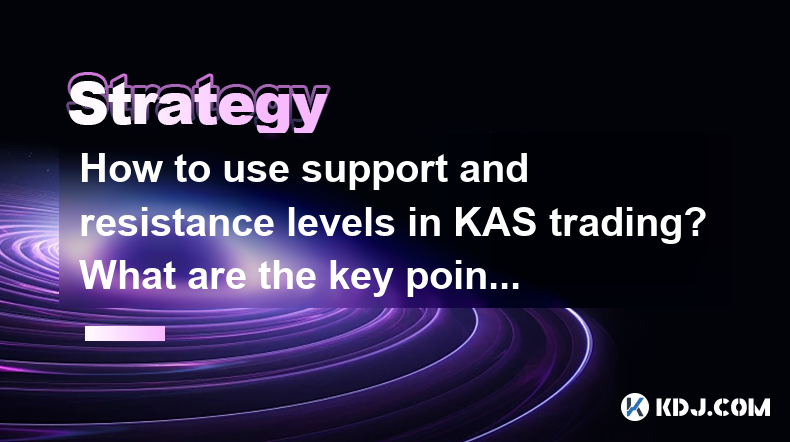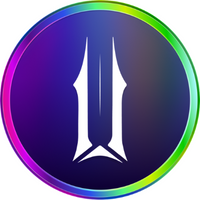-
 bitcoin
bitcoin $106975.071866 USD
-0.29% -
 ethereum
ethereum $3871.670850 USD
-0.07% -
 tether
tether $1.000261 USD
-0.01% -
 bnb
bnb $1084.417621 USD
-0.50% -
 xrp
xrp $2.348167 USD
0.82% -
 solana
solana $185.621736 USD
0.45% -
 usd-coin
usd-coin $0.999833 USD
-0.04% -
 tron
tron $0.313423 USD
0.81% -
 dogecoin
dogecoin $0.188856 USD
0.54% -
 cardano
cardano $0.630416 USD
-0.49% -
 hyperliquid
hyperliquid $36.506353 USD
2.24% -
 ethena-usde
ethena-usde $0.999584 USD
-0.01% -
 chainlink
chainlink $16.750026 USD
-0.77% -
 stellar
stellar $0.313373 USD
0.37% -
 bitcoin-cash
bitcoin-cash $465.978560 USD
-1.57%
How to use support and resistance levels in KAS trading? What are the key points of the line drawing tool?
Use support and resistance levels in KAS trading to identify entry and exit points, and employ the line drawing tool to visualize these levels on charts effectively.
Apr 30, 2025 at 06:29 am

Trading in the cryptocurrency market, particularly with KAS (Kaspa), involves understanding various technical analysis tools to make informed decisions. Among these tools, support and resistance levels play a crucial role in predicting price movements. Additionally, the line drawing tool is essential for identifying these levels on trading charts. This article will explore how to use support and resistance levels in KAS trading and delve into the key points of the line drawing tool.
Understanding Support and Resistance in KAS Trading
Support and resistance levels are fundamental concepts in technical analysis that help traders identify potential price turning points. In KAS trading, these levels are critical for determining entry and exit points.
Support levels are price points where the KAS price tends to find a floor, preventing it from falling further. This occurs because demand for the cryptocurrency increases at this level, often due to traders buying the dip. Conversely, resistance levels are price points where the KAS price tends to hit a ceiling, preventing it from rising further. This is typically due to increased selling pressure as traders take profits.
To identify these levels, traders often look at historical price data. By analyzing past price movements, traders can pinpoint where KAS has consistently bounced off or struggled to break through. These levels become more significant the more times the price tests them without breaking through.
How to Identify Support and Resistance Levels in KAS Trading
Identifying support and resistance levels involves a few key steps:
- Historical Price Analysis: Review past price charts to find levels where KAS has repeatedly bounced off or been rejected.
- Volume Confirmation: Look for increased trading volume at these levels, as it indicates stronger interest and potential validity of the level.
- Trendlines: Draw trendlines connecting the lows for support and the highs for resistance to visualize these levels more clearly.
- Psychological Levels: Consider round numbers as potential support and resistance levels, as they often influence trader psychology.
Utilizing the Line Drawing Tool for Support and Resistance
The line drawing tool is an essential feature in most trading platforms, allowing traders to manually draw lines on their charts to identify support and resistance levels. Here are the key points to consider when using this tool:
- Ease of Use: The line drawing tool is typically accessible through a simple click-and-drag interface, making it user-friendly for all levels of traders.
- Customization: Most platforms allow for customization of line color, thickness, and style, which can help distinguish between different types of levels or timeframes.
- Accuracy: The tool's accuracy depends on the trader's ability to identify significant price points. Practice and experience improve this skill.
- Multiple Timeframes: It's beneficial to draw lines on different timeframes to get a comprehensive view of potential support and resistance levels.
Steps to Use the Line Drawing Tool for KAS Trading
Using the line drawing tool effectively involves the following steps:
- Select the Tool: Access the line drawing tool from your trading platform's toolbar or menu.
- Identify Key Points: Look for significant highs and lows in the KAS price chart that align with your analysis of support and resistance.
- Draw the Line: Click and drag from one point to another to draw a line connecting these key points. Ensure the line is straight and accurately represents the level you are trying to identify.
- Review and Adjust: After drawing the line, review its placement and adjust as necessary to ensure it aligns with your analysis.
- Save and Monitor: Save the chart with your lines and monitor how the KAS price interacts with these levels over time.
Applying Support and Resistance Levels in KAS Trading Strategies
Once you have identified and drawn your support and resistance levels, you can apply them to your trading strategies:
- Breakout Trading: Watch for the KAS price to break through a resistance level, which could signal a potential uptrend. Conversely, a break below a support level might indicate a downtrend.
- Bounce Trading: Look for the price to bounce off a support or resistance level. This can be an opportunity to enter a trade in the direction of the bounce.
- Stop Loss and Take Profit: Use these levels to set stop-loss orders to limit potential losses and take-profit orders to secure gains.
Common Mistakes to Avoid When Using Support and Resistance Levels
Even experienced traders can fall into common pitfalls when using support and resistance levels:
- Over-reliance on a Single Level: Relying too heavily on one level without considering other factors can lead to missed opportunities or unnecessary losses.
- Ignoring Volume: Failing to confirm levels with volume can result in false signals.
- Neglecting Multiple Timeframes: Focusing on only one timeframe can miss important levels visible on other timeframes.
- Static Levels: Treating support and resistance as fixed rather than dynamic levels can lead to outdated analysis.
FAQs
Q1: How often should I redraw support and resistance levels in KAS trading?A1: It's advisable to review and potentially redraw support and resistance levels regularly, especially after significant price movements or when new data becomes available. This ensures your analysis remains current and relevant.
Q2: Can support and resistance levels be used for long-term KAS trading?A2: Yes, support and resistance levels can be applied to both short-term and long-term trading strategies. For long-term trading, consider using higher timeframes like daily or weekly charts to identify these levels.
Q3: Are there any automated tools for identifying support and resistance levels in KAS trading?A3: Yes, some trading platforms offer automated tools that can help identify potential support and resistance levels. However, it's important to use these tools as a supplement to your own analysis rather than a replacement.
Q4: How do I know if a support or resistance level is strong enough to trade on?A4: The strength of a support or resistance level can often be gauged by the number of times the price has tested it without breaking through, the volume at these levels, and the duration over which the level has held. Stronger levels are typically those that have been tested multiple times with high volume and have persisted over longer periods.
Disclaimer:info@kdj.com
The information provided is not trading advice. kdj.com does not assume any responsibility for any investments made based on the information provided in this article. Cryptocurrencies are highly volatile and it is highly recommended that you invest with caution after thorough research!
If you believe that the content used on this website infringes your copyright, please contact us immediately (info@kdj.com) and we will delete it promptly.
- SwiReasoning: A New Frontier for Reasoning Modes in Large Language Models
- 2025-10-19 16:30:12
- Bitcoin Treasury Companies: Bubble or Breakthrough?
- 2025-10-19 16:30:12
- Floki Price Check: Oversold? Bollinger Bands Tell the Tale!
- 2025-10-19 16:45:11
- WIF Tests, Meme Coin Mania, and Crypto Headwinds: A Deep Dive
- 2025-10-19 16:35:12
- Navigating Crypto Turbulence: INJ, Bollinger Bands, and Market Consolidation
- 2025-10-19 16:35:12
- PEPE's Consolidation: Meme Coin Sector Awaits the Next Big Wave
- 2025-10-19 16:40:15
Related knowledge

Practical parameter settings for a Bitcoin multi-timeframe moving average system
Sep 18,2025 at 10:54pm
Optimizing Timeframe Combinations for Bitcoin Trading1. Selecting appropriate timeframes is crucial when building a multi-timeframe moving average sys...

How can I filter out false breakouts in Dogecoin high-frequency trading?
Sep 22,2025 at 01:00am
Understanding False Breakouts in Dogecoin Trading1. A false breakout occurs when Dogecoin's price appears to move beyond a defined support or resistan...

Techniques for identifying tops and bottoms in the Bitcoin on-chain NVT model
Sep 20,2025 at 07:54pm
Understanding the NVT Model in Bitcoin Analysis1. The Network Value to Transactions (NVT) ratio is often described as the 'P/E ratio' of the cryptocur...

What does the surge in open interest in Bitcoincoin futures mean?
Sep 20,2025 at 11:18pm
Understanding the Surge in Dogecoin Futures Open Interest1. A surge in open interest within Dogecoin futures indicates a growing number of active cont...

How can I use the Ethereum USDT premium to gauge market sentiment?
Sep 18,2025 at 11:55pm
Understanding the Ethereum USDT Premium1. The Ethereum USDT premium refers to the price difference between USDT (Tether) traded on Ethereum-based plat...

What should I do if Ethereum staking yields decline?
Sep 20,2025 at 06:18am
Understanding the Causes Behind Declining Ethereum Staking Yields1. The Ethereum network transitioned to a proof-of-stake consensus mechanism with the...

Practical parameter settings for a Bitcoin multi-timeframe moving average system
Sep 18,2025 at 10:54pm
Optimizing Timeframe Combinations for Bitcoin Trading1. Selecting appropriate timeframes is crucial when building a multi-timeframe moving average sys...

How can I filter out false breakouts in Dogecoin high-frequency trading?
Sep 22,2025 at 01:00am
Understanding False Breakouts in Dogecoin Trading1. A false breakout occurs when Dogecoin's price appears to move beyond a defined support or resistan...

Techniques for identifying tops and bottoms in the Bitcoin on-chain NVT model
Sep 20,2025 at 07:54pm
Understanding the NVT Model in Bitcoin Analysis1. The Network Value to Transactions (NVT) ratio is often described as the 'P/E ratio' of the cryptocur...

What does the surge in open interest in Bitcoincoin futures mean?
Sep 20,2025 at 11:18pm
Understanding the Surge in Dogecoin Futures Open Interest1. A surge in open interest within Dogecoin futures indicates a growing number of active cont...

How can I use the Ethereum USDT premium to gauge market sentiment?
Sep 18,2025 at 11:55pm
Understanding the Ethereum USDT Premium1. The Ethereum USDT premium refers to the price difference between USDT (Tether) traded on Ethereum-based plat...

What should I do if Ethereum staking yields decline?
Sep 20,2025 at 06:18am
Understanding the Causes Behind Declining Ethereum Staking Yields1. The Ethereum network transitioned to a proof-of-stake consensus mechanism with the...
See all articles





















![[4K 60fps] Astral by oc3andark (1 Coin) [4K 60fps] Astral by oc3andark (1 Coin)](/uploads/2025/10/19/cryptocurrencies-news/videos/k-fps-astral-ocandark-coin/68f438453fa33_image_500_375.webp)




















































